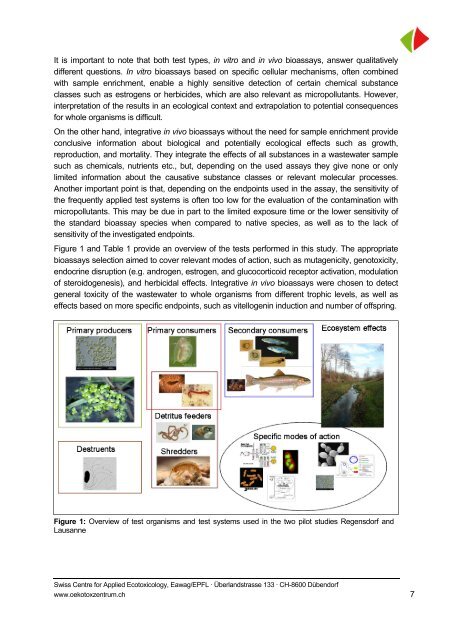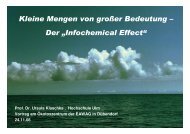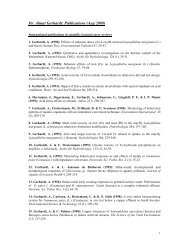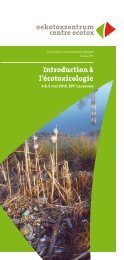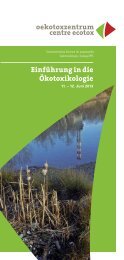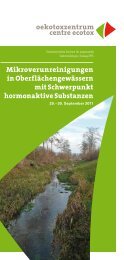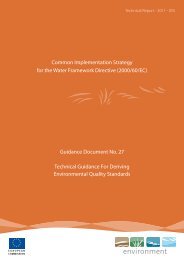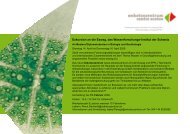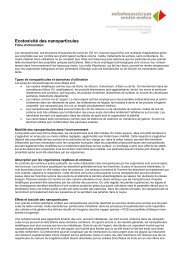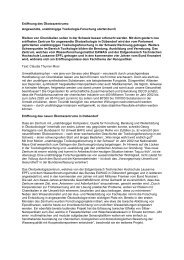Evaluation of Bioassays and Wastewater Quality ... - Oekotoxzentrum
Evaluation of Bioassays and Wastewater Quality ... - Oekotoxzentrum
Evaluation of Bioassays and Wastewater Quality ... - Oekotoxzentrum
Create successful ePaper yourself
Turn your PDF publications into a flip-book with our unique Google optimized e-Paper software.
It is important to note that both test types, in vitro <strong>and</strong> in vivo bioassays, answer qualitatively<br />
different questions. In vitro bioassays based on specific cellular mechanisms, <strong>of</strong>ten combined<br />
with sample enrichment, enable a highly sensitive detection <strong>of</strong> certain chemical substance<br />
classes such as estrogens or herbicides, which are also relevant as micropollutants. However,<br />
interpretation <strong>of</strong> the results in an ecological context <strong>and</strong> extrapolation to potential consequences<br />
for whole organisms is difficult.<br />
On the other h<strong>and</strong>, integrative in vivo bioassays without the need for sample enrichment provide<br />
conclusive information about biological <strong>and</strong> potentially ecological effects such as growth,<br />
reproduction, <strong>and</strong> mortality. They integrate the effects <strong>of</strong> all substances in a wastewater sample<br />
such as chemicals, nutrients etc., but, depending on the used assays they give none or only<br />
limited information about the causative substance classes or relevant molecular processes.<br />
Another important point is that, depending on the endpoints used in the assay, the sensitivity <strong>of</strong><br />
the frequently applied test systems is <strong>of</strong>ten too low for the evaluation <strong>of</strong> the contamination with<br />
micropollutants. This may be due in part to the limited exposure time or the lower sensitivity <strong>of</strong><br />
the st<strong>and</strong>ard bioassay species when compared to native species, as well as to the lack <strong>of</strong><br />
sensitivity <strong>of</strong> the investigated endpoints.<br />
Figure 1 <strong>and</strong> Table 1 provide an overview <strong>of</strong> the tests performed in this study. The appropriate<br />
bioassays selection aimed to cover relevant modes <strong>of</strong> action, such as mutagenicity, genotoxicity,<br />
endocrine disruption (e.g. <strong>and</strong>rogen, estrogen, <strong>and</strong> glucocorticoid receptor activation, modulation<br />
<strong>of</strong> steroidogenesis), <strong>and</strong> herbicidal effects. Integrative in vivo bioassays were chosen to detect<br />
general toxicity <strong>of</strong> the wastewater to whole organisms from different trophic levels, as well as<br />
effects based on more specific endpoints, such as vitellogenin induction <strong>and</strong> number <strong>of</strong> <strong>of</strong>fspring.<br />
Figure 1: Overview <strong>of</strong> test organisms <strong>and</strong> test systems used in the two pilot studies Regensdorf <strong>and</strong><br />
Lausanne<br />
Swiss Centre for Applied Ecotoxicology, Eawag/EPFL · Überl<strong>and</strong>strasse 133 · CH-8600 Dübendorf<br />
www.oekotoxzentrum.ch<br />
7


